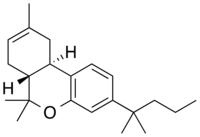JWH-133
 | |
| Identifiers | |
|---|---|
| |
| CAS Number | |
| PubChem CID | |
| IUPHAR/BPS | |
| ChemSpider | |
| ChEMBL | |
| Chemical and physical data | |
| Formula | C22H32O |
| Molar mass | 312.489 g/mol |
| 3D model (JSmol) | |
| |
| |
| | |
JWH-133 is a potent selective CB2 receptor agonist with a Ki of 3.4nM and selectivity of around 200x for CB2 over CB1 receptors. It was discovered by and named after, John W. Huffman.
JWH-133, alongside WIN 55,212-2 and HU-210, is responsible for preventing the inflammation caused by Amyloid beta proteins involved in Alzheimer's Disease, in addition to preventing cognitive impairment and loss of neuronal markers . This anti-inflammatory action is induced through agonist action at cannabinoid receptors, which prevents microglial activation that elicits the inflammation. Additionally, cannabinoids completely abolish neurotoxicity related to microglia activation in rat models.
It may be linked with anti-cancer properties, according to pre-trial data from a 2010 study in Madrid.[1]
Legal Status
The substance commonly referred to as "JWH-133" is not a scheduled substance in the U.S, except in Alabama.[2] Low abuse potential makes it less likely for regulation relative to its sister drugs such as JWH-018, as JWH-133 is selective for the non-psychoactive CB2 receptor and thus lacks significant psychoactive effects.[3]
References
- ↑ http://www.enewspf.com/index.php/latest-news/health-and-fitness/18029-marijuana-compound-halts-breast-cancer-tumor-growth-
- ↑ "Alabama Senate Bill 333 - Controlled substances, Schedule I, additional synthetic controlled substances and analogue substances included in, trafficking in controlled substance analogues, requisite weight increased, Secs. 13A-12-231, 20-2-23 am'd". March 2014. Retrieved 28 September 2015.
- ↑ http://www.usdoj.gov/dea/pubs/scheduling.html
External links
- JNeurosci.org Prevention of Alzheimer's Disease Pathology by Cannabinoids: Neuroprotection Mediated by Blockade of Microglial Activation Also has been shown to block grown of tumors. More clinical studies and trials are needed.